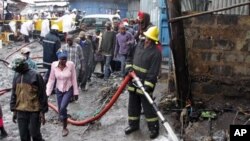For Kenyan journalist John Ngirachu, Monday’s pipeline explosion that claimed more than 80 lives in Nairobi's Sinai slum was entirely predictable.
In 2009 he wrote "The fire next time: Slum courts doom" for Kenya’s Daily Nation, which identified potentially catastrophic fire risks lurking within the informal settlement where some 100,000 people reside within meters a major gasoline pipeline.
“They acknowledged the danger they lived in and the fact that they need to move," he says. "But I think, due to the nature of their lives, they do not have anywhere to go and would have to be moved by the government.”
Residents were given eviction notices by the state-owned Kenya Pipeline Corporation in 2008, but Ngirachu says the government officials, after promising to compensate people for relocation, looked the other way when they continued living there.
In other Nairobi slums, Ngirachu reported that squatters refused to relocate unless the government first agreed to provide compensation, though officials say they had never made such promises.
Justus Nyang'aya, director of human rights group Amnesty International-Kenya, says failure to relocate people - regardless of compensation - puts the majority of blame squarely on government officials.
"We need to have a government that plans," he says, explaining that rescue efforts were hampered by the fact that there are few roads within Sinai, making access difficult. "This planning needs to [address] access but it also needs to include water, it needs to include security."
The conflagration, abetted by fuel that residents stored in their domiciles, razed tin-roofed shacks.
"We need to have houses that are adequate and decent, even if they are for low-income earners," Nyang'aya says. "That requires planning."
According to Energy Minister Kiraitu Murungi, trouble began when a pipeline valve failed under presser, allowing fuel to spill into an open sewer. Crowds of people went to scoop up the fuel and then somewhere a spark ignited.
In a national press report, Selest Kilinda, managing director of Kenya Pipeline Corporation, says petrol spilled from two pipelines and that a team of engineers de-pressurized the Sinai pipeline, but only after the fuel had entered the sewage system.
Another press report quoted engineers as saying the company's pipeline system is run-down, old and in need of replacement.
Despite repeated attempts, VOA was unable to get comments from officials at Kenya Pipeline Corporation.
Sinai is one of hundreds of Nairobi's informal settlements where many residents earn less than two dollars a day, and sanitation, health and other facilities are at a minimum.
The Red Cross has been increasing the death toll as rescue workers continue to find charred bodies. More than 120 people have been admitted to hospitals, most suffering severe burns.






